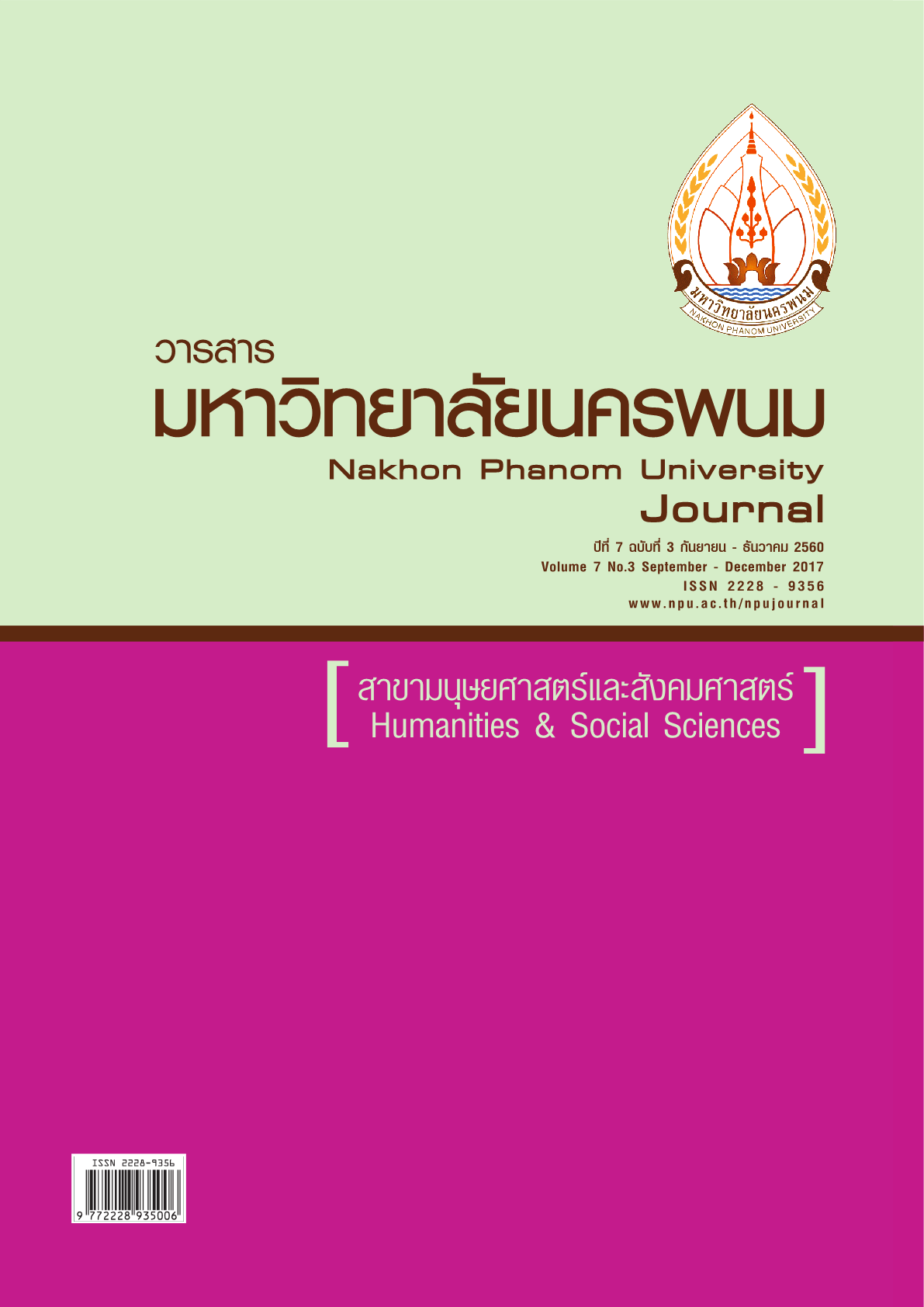การบริหารจัดการในศตวรรษที่ 21 ที่สัมพันธ์กับการใช้ใช้นวัตกรรมในสถานศึกษา
Main Article Content
Abstract
การบริหารจัดการในศตวรรษที่ 21 ที่สัมพันธ์กับการใช้นวัตกรรมในสถานศึกษา
The management in the 21st Century in the relation to
innovation usage in school
ภาณุมาส ควรครู[1] ชาญวิทย์ หาญรินทร์[2] และ รชฏ สุวรรณกูฏ[3]
Panumas Khounkroo1, Chanwit Hanrin2 and Ratchata Suvannagoot3
บทคัดย่อ
การวิจัยนี้มีวัตถุประสงค์ 1) เพื่อศึกษาการบริหารจัดการในศตวรรษที่ 21 กับการใช้นวัตกรรมในสถานศึกษาของโรงเรียนสังกัดสำนักงานเขตพื้นที่การศึกษาประถมศึกษานครพนม เขต 1 2) เพื่อเปรียบเทียบความคิดเห็นเกี่ยวกับการบริหารจัดการในศตวรรษที่ 21 กับการใช้นวัตกรรมในสถานศึกษา ของผู้บริหารกับครูผู้สอนในโรงเรียนสังกัดสำนักงานเขตพื้นที่การศึกษาประถมศึกษานครพนม เขต 1 โดยจำแนกตามสถานภาพและขนาดของสถานศึกษา 3) เพื่อหาความสัมพันธ์ของการบริหารจัดการในศตวรรษที่ 21 กับการใช้นวัตกรรมในสถานศึกษา ในโรงเรียนสังกัดสำนักงานเขตพื้นที่การศึกษาประถมศึกษานครพนม เขต 1 กลุ่มตัวอย่างได้แก่ ผู้บริหารและครู จำนวน 408 คน ได้มาโดยการการสุ่มกลุ่มตัวอย่างแบบชั้นภูมิ(Stratified Random Sampling) เครื่องมือที่ใช้ เป็นแบบสอบถามมาตราส่วนประมาณค่า 5 ระดับ ค่าอำนาจจำแนก อยู่ระหว่าง 0.67 - 0.89 มีค่าความเชื่อมั่นทั้งฉบับเท่ากับ 0.98 สถิติที่ใช้ในการวิเคราะห์ข้อมูล ได้แก่ ร้อยละ ค่าเฉลี่ย ส่วนเบี่ยงเบนมาตรฐาน ทดสอบสมมติฐานโดยใช้ t-test และ F – test (Two way Anova) และการหาค่าสัมประสิทธิ์สัมพันธ์อย่างง่ายของเพียร์สัน (Pearson’ s Product Moment Correlation Coefficient)
ผลการวิจัยพบว่า 1) การบริหารจัดการในศตวรรษที่ 21 และการใช้นวัตกรรมในสถานศึกษา ตามการรับรู้ของผู้บริหารสถานศึกษาและครูโดยรวมอยู่ในระดับมาก 2) การบริหารจัดการในศตวรรษที่ 21 และการใช้นวัตกรรมในสถานศึกษาตามการรับรู้ของผู้บริหารสถานศึกษาและครูโดยรวม ไม่แตกต่างกัน 3) การบริหารจัดการในศตวรรษที่ 21 และการใช้นวัตกรรมในสถานศึกษาตามการรับรู้ของผู้บริหารสถานศึกษาและครู เมื่อจำแนกตาม ขนาดของสถานศึกษาโดยรวมไม่แตกต่างกัน 4) การบริหารจัดการในศตวรรษที่ 21 มีความสัมพันธ์กับการใช้นวัตกรรมในสถานศึกษา ในระดับสูง อย่างมีนัยสำคัญทางสถิติที่ระดับ .01
คำสำคัญ: การบริหารจัดการในศตวรรษที่ 21 ; การใช้นวัตกรรมในสถานศึกษา ; ความสัมพันธ์การบริหารกับการใช้นวัตกรรม
ABSTRACT
This research aims 1) to study management in the 21st century with the use of innovation in schools under In schools under the Primary Education of Nakhon Phanom Service Area Office 1 2) to compare opinions on the management in the 21st century with the use of educational innovation in administrators and teachers in schools under the Primary Education of Nakhon Phanom Service Area Office 1, classified by the status and size of the school 3) to determine the relationship of the management in the 21st century with the use of innovation in education in schools under the Primary Education of Nakhon Phanom Service Area Office 1. The sample used in this study were selected by the random sampling stratum (Stratified Random Sampling). On the total sample of 408 peoples. Tools used in research was a five rating scales questionnaire with discrimination between 0.67 to 0.89 and all queries reliability was 0.98. The statistics used for analyze data were percentage, average, standard deviation. Hypothesis testing using t-test and F - test (Two way Anova) and simple correlation coefficient of Pearson (Pearson 's Product Moment Correlation Coefficient).
The results showed that: (1) Management in the 21st Century and the use of innovation in education. According to the recognition of the school administrators and teachers were at a high level (2) When comparing of different status administrators and teachers were not difference significant in overall. (3) Management in the 21st Century and the use of innovation in education based on the recognition of the school administrators and teachers when classified by The size of the school as a whole was not different (4) Management in the 21st century in relation to the use of innovation in the higher education level of statistical significance. 01.
Keywords: 21st century management ; Innovation usage in school ; Relationship of school management -
- and innovation usage
[1] นักศึกษาปริญญาโท สาขาการบริหารการศึกษา คณะครุศาสตร์ มหาวิทยาลัยนครพนม, Graduated Student in Department of Education Administration, Faculty of Education, Nakhon Phanom University
2 ผู้ช่วยศาสตราจารย์คณะครุศาสตร์ มหาวิทยาลัยนครพนม, Assist. Prof., Faculty of Education, Nakhon Phanom University
3 อาจารย์คณะครุศาสตร์ มหาวิทยาลัยนครพนม, Lecturer, Faculty of Education, Nakhon Phanom University


